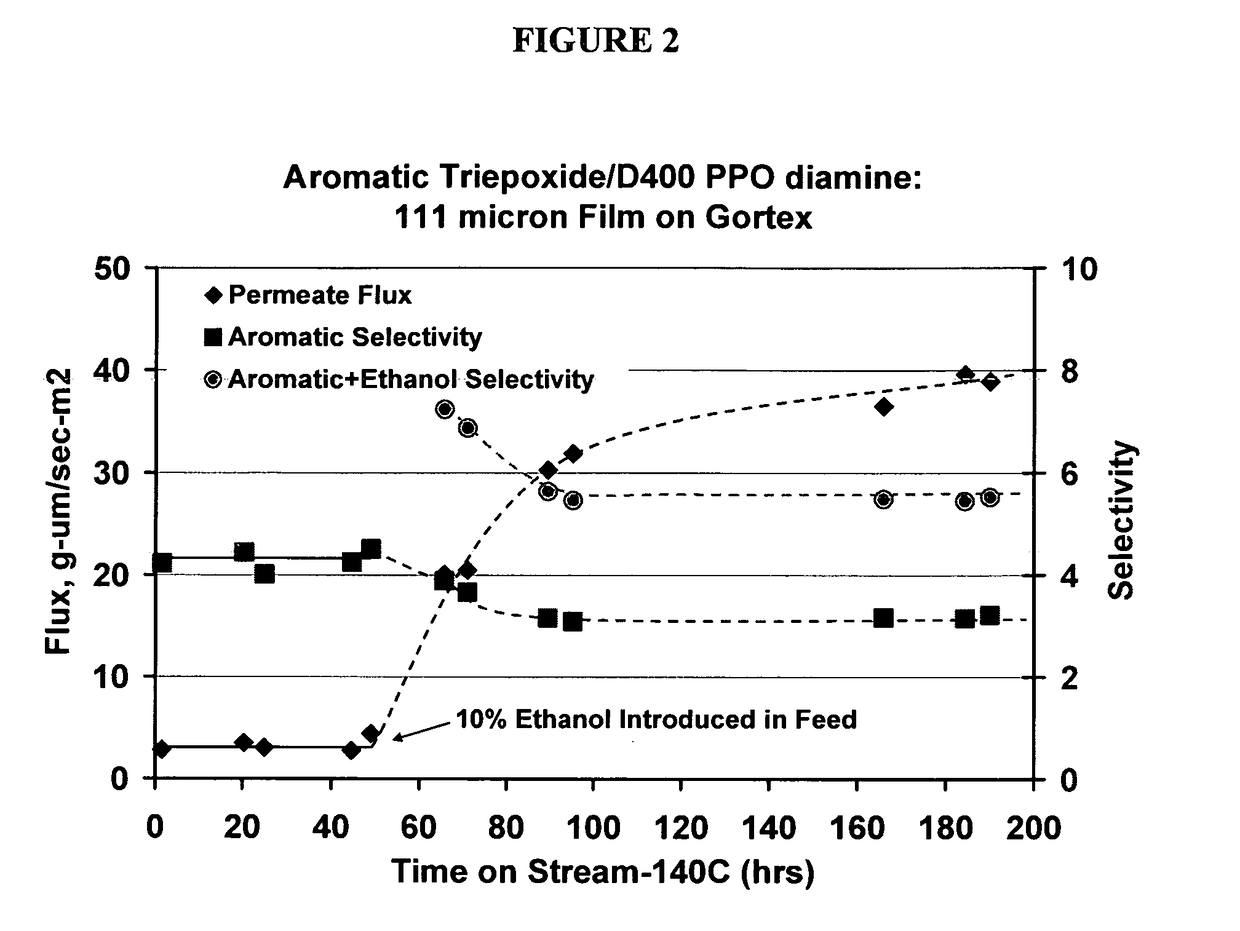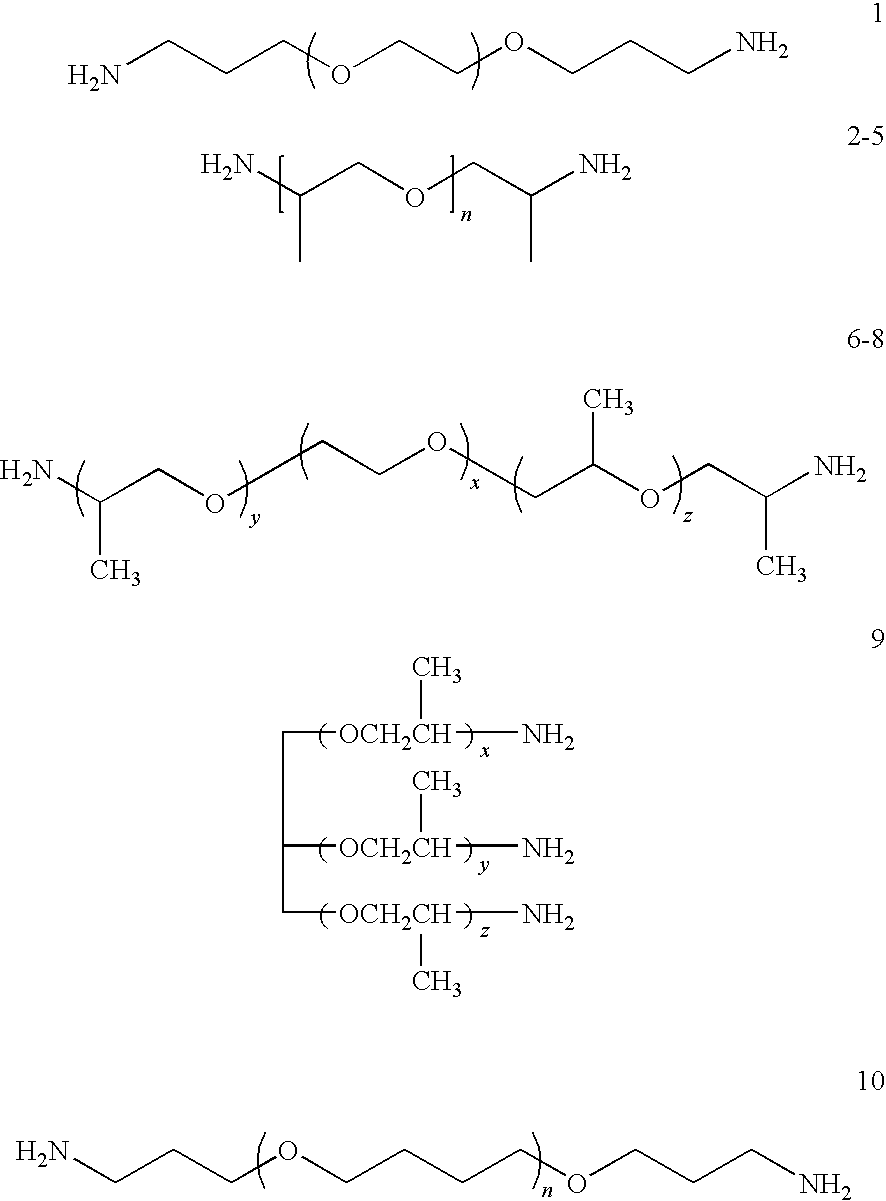Ethanol stable epoxy amine based membrane for aromatics separation
a technology of epoxy amine and aromatics, which is applied in the direction of hydrocarbon oil treatment products, separation processes, water/sewage treatment, etc., can solve the problems of high operational and maintenance costs, high installation and operation costs of conventional separation processes such as distillation and solvent extraction, and high installation and operation costs
- Summary
- Abstract
- Description
- Claims
- Application Information
AI Technical Summary
Benefits of technology
Problems solved by technology
Method used
Image
Examples
example 1
Reaction of poly(bisphenol A-co-epichlorohydrin), glycidyl end-capped diepoxide with poly(propyleneglycol) bis(2-aminopropylether) Jeffamine D-230 polyether amine
[0055]0.81 g of poly(propyleneglycol) bis(2-aminopropylether) Jeffamine D-230 polyether amine (Mn 230, 3.5 mmol) and 2 g of poly(bisphenol A-co-epichlorohydrin), glycidyl end-capped (Mn 377, 5.3 mmol) are mixed in 0.5 g of toluene in the mole ratio of 1:51. The solution was poured into aluminum pan and solvent was allowed removed at room temperature over a period of 16 hours. The mixture was heated at 60° C., 100° C. and 140° C. respectively for 2 hour each. The film was then cooled to room temperature and removed from the aluminum pan.
[0056]The TGA Testing determined the selectivity of the polymer membrane for toluene and heptane to be 3.65. The Ethanol Stability Testing determined that is the film was intact and lost about 3.79 wt % at 150° C. in 72 hours
example 2
Reaction of poly(bisphenol A-co-epichlorohydrin), glycidyl end-capped diepoxide with poly(propyleneglycol) bis(2-aminopropylether) Jeffamine D-400 polyether amine
[0057]1.41 g of poly(propyleneglycol) bis(2-aminopropylether) Jeffamine D-400 polyether amine (Mn 400, 3.5 mmol) and 2 g of poly(bisphenol A-co-epichlorohydrin), glycidyl end-capped (Mn 377, 5.3 mmol) are mixed in 0.5 g of toluene in the mole ratio of 1:51. The solution was poured into aluminum pan and solvent was allowed removed at room temperature over a period of 16 hours. The mixture was heated at 60° C., 100° C. and 140° C. respectively for 2 hour each. The film was then cooled to room temperature and removed from the aluminum pan.
[0058]The TGA Testing determined membrane selectivity of the polymer membrane for toluene and heptane was 5.67. The Ethanol Stability Testing determined that the film was intact and lost 2.77 wt % at 150° C. in 72 hours.
example 3
Reaction of poly(bisphenol A-co-epichlorohydrin), glycidyl end-capped diepoxide with poly(propyleneglycol) bis(2-aminopropylether) Jeffamine D-2000 polyether amine
[0059]3.54 g of poly(propyleneglycol) bis(2-aminopropylether) Jeffamine D-2000 polyether amine (Mn 2000, 1.77 mmol) and 1 g of poly(bisphenol A-co-epichlorohydrin), glycidyl end-capped (Mn 377, 2.65 mmol) are mixed in 0.5 g of toluene in the mole ratio of 1.5. The solution was poured into aluminum pan and solvent was allowed removed at room temperature over a period of 16 hours. The mixture was heated at 60° C., 100° C. and 140° C. respectively for 2 hour each. The is film was then cooled to room temperature and removed from the aluminum pan.
[0060]The TGA Testing determined membrane selectivity of the polymer membrane for toluene and heptane was 2.17. The Ethanol Stability Testing of the polymer film determined that the film was intact and lost 9.56 wt % at 150° C. in 72 hours.
PUM
| Property | Measurement | Unit |
|---|---|---|
| temperatures | aaaaa | aaaaa |
| thickness | aaaaa | aaaaa |
| temperature | aaaaa | aaaaa |
Abstract
Description
Claims
Application Information
 Login to View More
Login to View More - R&D
- Intellectual Property
- Life Sciences
- Materials
- Tech Scout
- Unparalleled Data Quality
- Higher Quality Content
- 60% Fewer Hallucinations
Browse by: Latest US Patents, China's latest patents, Technical Efficacy Thesaurus, Application Domain, Technology Topic, Popular Technical Reports.
© 2025 PatSnap. All rights reserved.Legal|Privacy policy|Modern Slavery Act Transparency Statement|Sitemap|About US| Contact US: help@patsnap.com



